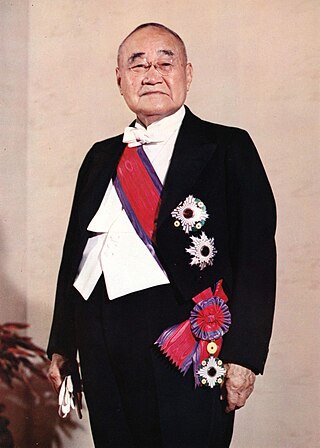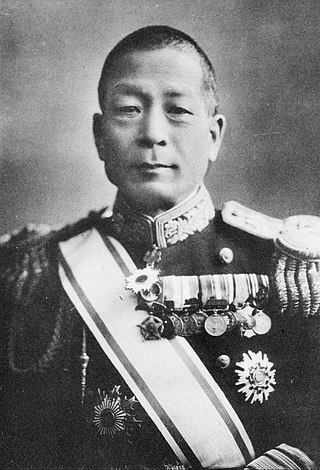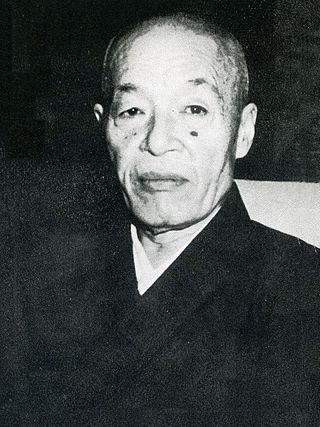
Shigeru Yoshida was a Japanese diplomat and politician who served as Prime Minister of Japan from 1946 to 1947 and from 1948 to 1954, serving through most of the American occupation following the Pacific War. He played a significant part in determining the course for post-war Japan by forging a strong relationship with the United States and pursuing economic recovery.

Ichirō Hatoyama was a Japanese politician who served as Prime Minister of Japan from 1954 to 1956. During his tenure he oversaw the formation of the Liberal Democratic Party and restored official relations with the Soviet Union.

The Asahi Shimbun is one of the five largest newspapers in Japan. Founded in 1879, it is also one of the oldest newspapers in Japan and Asia, and is considered a newspaper of record for Japan. Its circulation, which was 4.57 million for its morning edition and 1.33 million for its evening edition as of July 2021, was second behind that of the Yomiuri Shimbun. By print circulation, it is the second largest newspaper in the world behind the Yomiuri, though its digital size trails that of many global newspapers including The New York Times.

The chief cabinet secretary of Japan is a member of the cabinet and is the leader and chief executive of the Cabinet Secretariat of Japan. The chief cabinet secretary coordinates the policies of ministries and agencies in the executive branch, and also serves as the government's press secretary. The secretary is a statutory member of the National Security Council, and is appointed by the emperor upon the nomination by the prime minister. The chief cabinet secretary is the second in line of succession to the prime minister, and 1st if the office of the deputy prime minister is unoccupied.
Events in the year 1946 in Japan.

Takeru Inukai was a Japanese politician and novelist active in Shōwa period Japan. Also known as "Inukai Ken", he was the third son of Prime Minister of Japan Inukai Tsuyoshi.

The 1955 system (55年体制), also known as the one-and-a-half party system, is a term used by scholars to describe the dominant-party system that has existed in Japan since 1955, in which the Liberal Democratic Party (LDP) has successfully held by itself or in coalition with Komeito a majority government nearly uninterrupted, with opposition parties largely incapable of forming significant or long lasting alternatives, other than for brief stints in 1993–1994 and 2009–2012. The terms 1955 system and the one-and-a-half party system are credited to Junnosuke Masumi, who described the 1955 system as "a grand political dam into which the history of Japanese politics surge".

Zengo Yoshida was an admiral in the Imperial Japanese Navy.

General elections were held in Japan on 23 January 1949. The result was a landslide victory for the Democratic Liberal Party, which won 269 of the 466 seats. Voter turnout was 74.0%. It was the first election held following the enactment of the current Constitution of Japan.

General elections were held in Japan on 25 April 1947. The Japan Socialist Party won 143 of the 468 seats, making it the largest party in the House of Representatives following the election. Voter turnout was 68%. It was the last election technically held under the Meiji Constitution in preparation for the current Constitution of Japan which became effective several days later on 3 May 1947. The upper house of the Diet was also elected by the people under the new constitution, the first ordinary election of members of the House of Councillors had been held five days before.

Shigeru Yoshida, was bureaucrat and politician in the Empire of Japan, serving as a member of the Upper House of the Diet of Japan, Chief Cabinet Secretary, governor of Fukuoka Prefecture and twice as a cabinet minister.

Bukichi Miki was a Japanese politician. He was a close friend and ally of Ichiro Hatoyama, and was the key figure in carrying out the "conservative merger" that resulted in the formation of the Liberal Democratic Party.

The Katayama Cabinet governed Japan under the premiership of Tetsu Katayama from 24 May 1947 to 10 March 1948, during the Allied occupation. It was the first cabinet under the postwar constitution.

The Third Abe cabinet governed Japan under the leadership of the prime minister, Shinzō Abe, from December 2014 to November 2017. The government was a coalition between the Liberal Democratic Party and the Komeito and controlled both the upper and lower houses of the National Diet.
Hello Ninja is a children's animated television series based on the book of the same name by N.D. Wilson airing on Netflix.

The First Yoshida Cabinet was the 45th Cabinet of Japan led by Shigeru Yoshida from 22 May 1946 to 24 May 1947, during the Allied occupation.

The Second Yoshida Cabinet is the 48th Cabinet of Japan. It was headed by Shigeru Yoshida from 15 October 1948 to 16 February 1949, during the Allied occupation.

The Third Yoshida Cabinet was the 49th Cabinet of Japan. It was headed by Shigeru Yoshida from 16 February 1949 to 30 October 1952.

The Fifth Yoshida Cabinet was the 51st Cabinet of Japan. It was headed by Shigeru Yoshida from May 21, 1953 to December 10, 1954.
Yoshida Cabinet may refer to:


















